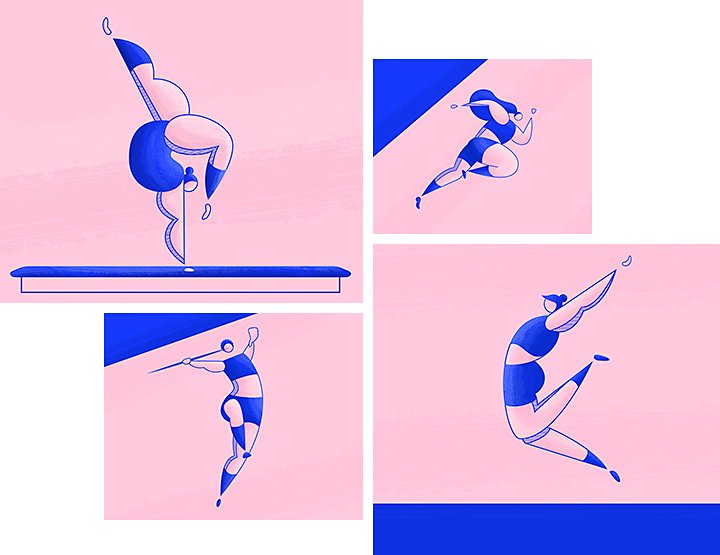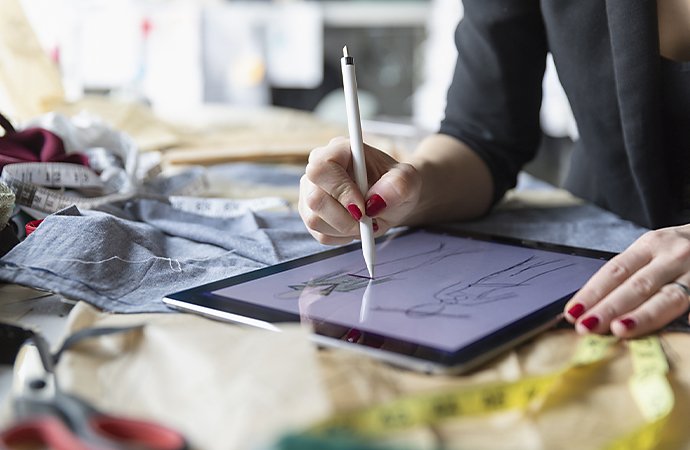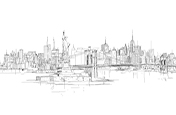How to draw dynamic poses.
Action poses infuse your figure drawings with life and energy. Learn to capture the human figure in motion and stretch your artistic abilities.

What are dynamic poses?
A dynamic pose is one that depicts movement in the subject. Rather than a still, static figure, a dynamically posed drawing will portray a body in motion: leaping, dancing, running. Whether you want to draw character art, anime, manga, or just want to get better at sketches of the human body, you can hone new skills by drawing poses that leap off the page.
Anatomy is key.
Once you’ve got a handle on figure drawing (also known as life drawing, the practice of sketching the human form) and you’re ready for your next challenge, it’s time to take your model out of the chair and into the world of action. Before you start, note that a couple things will help set you up for success.
For effective human figure drawing, the first tool you’ll want is a basic knowledge of anatomy. Anatomical knowledge will help you more accurately draw proportions and muscle movements, and it’s the best way to ensure limbs you sketch move within the range of natural movement. You don’t have to carry an anatomy book at all times. After all, mastery of the human body is a lifelong process for any artist. But it doesn’t hurt to study up on your muscle groups and have reference photos at the ready.
Secondly, a solid foundation in figure drawing brings a lot to your dynamic poses. The basics of figure drawing help you apply your anatomy drawing skills to the human form before moving on to more complex dynamic poses. But regardless of where you are on your drawing journey, action poses present unique challenges every time for novices and experienced artists alike.

Switch up your perspective.
“This is how you sell a dynamic pose. You can draw from eye level or a flat view, but if you add perspective and extra exaggeration in the camera angle, that can really push it further,” says artist Megan Levens. For instance, imagine a superhero flying toward the camera. “You could draw the character flying straight on or you can bring the camera below. It looks way cooler if Superman is flying at you and over you rather than just straight at you,” explains Levens.
Follow the line of action.
The line of action, also referred to as the line of energy, is the essential trajectory the body follows all the way through a movement. Think of it as the backbone of your pose. When you think in terms of energy lines while you draw, it will help you keep your drawing fluid and natural. “It’s less about building blocks and more about thinking through movement and the direction energy is moving,” Levens explains. Remember that body parts don’t move in isolation; neither should parts in your figure drawing.
Establish your line of action first, and let the body take shape from the line. “You’re really just building a stick figure and getting the motion of where energy is going in the body, then building on top of that with your anatomy,” says Levens.
Be sure to stay away from straight lines. “Always have some type of roundedness to your lines. With straight lines, your figure comes out very stiff and lifeless,” explains artist Shiela Larson.

Draw from life.
Make your drawings look more realistic by using real-life references. Photo references are a great resource. A search on Behance or Adobe Stock can unearth new and different poses to sketch. If you can’t find the exact pose you’re looking for, you can always create your own reference image. “If you have friends who like performing, take photos of them in extreme foreshortening, or low or high camera angles to get a sense of how the body recedes or advances in perspective,” suggests Levens. Foreshortening refers to the depth effect that occurs when part of your subject is closer to the camera, which alters the appearance of proportions. You can take advantage of this natural distortion in your photo references to render receding lines in a more visually captivating way.
And if there’s no one around to photograph, you can always turn the camera around and act out the pose yourself. This can help you better identify the feeling of the line of action in a human body. Photos go a long way, but in the end they are still static portrayals of action and can lose that authenticity so crucial to conveying movement. “Don’t get too married to your reference photo,” advises Levens. “There’s a point where you have to infuse that last little bit of motion back into the drawing yourself.” You can do this by mimicking the motion as you draw, similarly to how animators make expressions while they animate them. “Act out the pose yourself as best you can and don’t be afraid to look a little crazy,” says Levens.


Drawing tutorials and inspiration to jump-start your learning.
Get faster with quick pose figure drawing.
Drawing quick poses with time limits is a great way to help you get faster and hone your gesture drawing and dynamic pose skills. Learn more in this case study of action poses that artist Twosenseless created using Adobe Fresco.
Learn character design fundamentals.
Follow along with illustrator Sam Peterson as he shows you how to render 3D figures and capture the human form. Get tips for digital drawing and painting as Peterson takes his artwork from sketched line drawings to finished art.
Illustrate comic book characters.
In this step-by-step art tutorial, illustrator Logan Faerber draws comic art of Black Panther from start to finish. Comic book art is a great source to find cool poses with lots of action, such as foreshortened angles of characters fighting.
Parting tips.
Get your art references from the pros. Absorb concept art from films, video games, comic books, and beyond, and you’ll gain exposure to a variety of top-notch character design references. For instance, every frame of a Disney movie is a chance to study dynamic character drawing in action. A quick Google search for your favorite characters could inspire your next great pose reference.
Don’t be afraid to get messy. Pull out your sketchbook or digital drawing pen and start making quick strokes. “It’s muscle memory,” says Levens. “It's like riding a bike: The more you do it, the more you’ll remember the motions and how the pieces fit together.” Keep practicing and focus on ingraining the movements and motions into your hand.
Dynamic poses are all about exploring the human form through its many movements. Start to put your drawings in motion and don’t be discouraged by what you perceive as mistakes. Always leave room for the unexpected. After all, drawing true-to-life motion is more about fluidity than rigid precision.
Contributors
Megan Levens, Shiela Larson
You might also be interested in…
How to become a professional illustrator.
Get tips on portfolio creation and art presentation to help you kick off a new career.
Take your skills to the next level with drawing exercises and advice from professional illustrators.
Try your hand at pencil sketching.
Pencil drawing is an essential first step for most artists. See how this skill can improve your art.
Make your mark with ink drawing.
Explore the subtlety and boldness of ink drawing with these tips and techniques.



